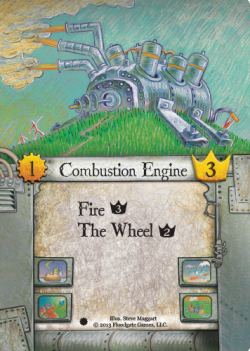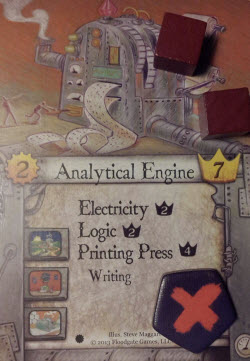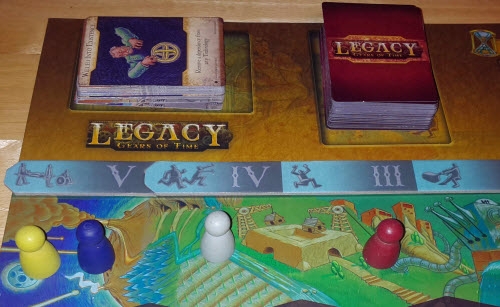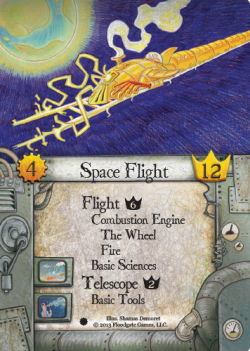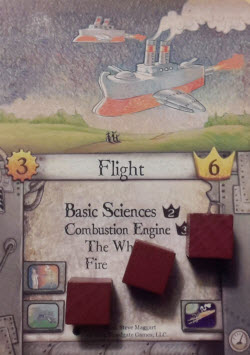Sebbon Hai sat in her office chair, looking over the week’s status reports. Trains were running, banks were open, and scientific progress was right on track. It was a nice change of pace from the Ox Plow incident of last month, she figured, as she sipped her camomile tea and signed off on the paperwork.
A series of lights flickered into view from her desk’s center console, each corresponding today’s start-up sequence system check. Temporal servos? Check. Quantum tether? Check. Angstrom Stabilizers? Haab-Dione Stabilizers? Fully charged.
Everything appeared to be nominal, and the final green light reinforced that thought. The Machine was powered up and ready to go.
Sebbon picked up her phone to the control room. “Sebbon here. Today’s expedition is clear to depart. Let’s put this ‘videocassette recorder’ item back on the grid…Oh, and Alec, if you can manage it, have them swing through the radio timeline. The damn thing disappeared again, and my office is way too quiet.”
The Premise
Welcome to the world of Legacy, a land where maintenance of its past achievements is overseen by The Ancient Machine. Players take on the roles of competing time traveling engineers, called Antiquitects, who must travel back through history and ensure the timelines of inventions remain as unaltered as possible.
The Rules
Legacy: Gears of Time is a time-traveling card game with a central board, and while setup is minimal, it requires a fair amount of table space.
To begin, the Present Day marker is placed on one of the board’s Timeframe segments, which depends on the number of players. A Sequential Capacity track is placed to the left of that marker, denoting the invention limits in that Timeframe.
Each player receives a pawn and matching set of Influence Cubes, as well as a character card. Characters in Legacy are mechanically identical, with the one exception of the technology VP bonus they provide.
Players also receive a starting hand of six cards. Cards in Legacy consist of two kinds: Technology and Fate. Technology cards are the various inventions players place and control throughout the game, whereas Fate cards are one-time special effects cards that provide powerful effects.
Legacy is played out over four rounds, and each round is broken down into four turns. The starting player is either determined randomly, or based on something time-related. Players then select their desired turn order, with those not going first receiving additional cards.
A player’s turn consists of three actions, taken in any order or amount they wish. These include:
- Traveling: The player moves to an older Timeframe from their current position.
- Establishing A Technology: As long as their current Timeframe isn’t at capacity or possesses a duplicate Technology, the player may play a Technology by discarding cards equal to the its cost. They then place that many Influence Cubes on it from their supply. Additionally, most Technologies require prerequisite inventions which must exist in a previous Timeframe to be considered “active” at the end of the round.
- Influencing a Technology: The player may place any number of Influence Cubes from their Influence Pool on a Technology in their Timeframe. (Players begin with an empty Influence Pool.)
- Drawing: The player draws two cards, keeping one and discarding the other.
Players may also use any number of Fate cards on their turn and do not require an action.
After each player has taken four turns, the round ends. Players return to the Present Day location, and scoring happens. First, any Technologies without Influence Cubes are discarded, as are any duplicate Technologies, and Technology dependencies are checked.
Then, players score points if their character’s bonus is successful and for each active (non-Failed) Technology the have. Players receive additional points each time a Technology depends on one they control. Lastly, one Influence Cube from each Technology is removed. Cubes from successful Technologies go to the player’s Influence Pool; those from Failed Technologies are returned to their supply.
Then, a new round begins. The Present Day and Capacity Markers shift one Timeframe to the right, players draw back up to six cards, a new turn order is established, based on the amount Influence Cubes in their Pool.
At the end of four rounds, the Antiquitect with the highest VP total is the winner. They have displayed themselves to be the best suited at navigating the complex and jumbled time streams, and they will be rewarded with their own TARDIS.
Everyone else should expect longer hours and will be required to show up to work promptly at 8AM yesterday.
A Mixed Palette
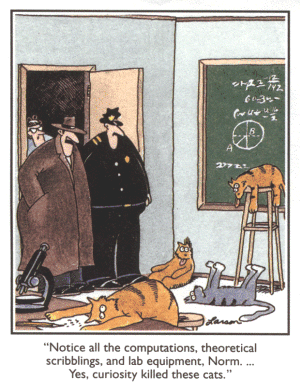
The cats of Legacy?
It’s not uncommon for games to have trouble differentiating themselves from one another on shelves, and so designers try to come up with different ways to make them alluring. Legacy is one such game, as is evidenced in the game’s artwork. Legacy: Gears of Time presents a uniquely crafted visual canvas, from the scenes depicted to the style in which it’s done.
The art is like an Impressionist’s version of Gary Larson’s Far Side cartoons: interesting and unconventional. Many illustrations are almost farcical in nature, such as Railroads being Viking ships on train tracks or Microscopes being giant binoculars turned downwards, but they’re still subdued enough as to not make the game seem silly. It’s simultaneously surreal and unobtrusive – so much so that you may not initially notice the board’s Timeline is one large mural depicting the progress of the Legacy’s civilization.
However, don’t be surprised if it’s not a universal hit. Legacy’s color scheme and stylistic choices won’t appeal to everyone. It’ll be a polarizing aspect, as some will find its lighthearted nature to be a detraction from the game’s more Euro-style gameplay, rather than an asset. Legacy is essentially one big logic puzzle, and those who prefer to focus on that attribute will find the juxtaposition of form and function here mismatched. Yet this issue stems more from a specific style of art particularly prone to causing such a reaction more than gameplay itself.
That said, don’t expect Immersionists to flock to Legacy: Gears of Time. Outside of an interesting premise and very basic backstories for the character sheets, there isn’t much for these narrative-driven folks to latch on to. What’s more, the game’s presentation is not perfect. While Legacy’s artwork itself is well done, the earthy tones and darker shades don’t translate as well on the board. It’s often difficult to see all of the little details of said mural. Simply adjusting the board’s brightness levels would solve this issue and make the board look more appealing. Moreover, adding numbered columns or cells to the game’s VP track would make the game’s four scoring rounds easier.
Hurry Up And Wait!
The end-of round scoring is admittedly the most tedious and time-consuming part of Legacy, requiring a pause in the game and thorough inspection of the board each time. It’s not the Technologies themselves that cause this, but rather having to check each of the Technology’s dependencies too. There are a number of ways you can handle this, but we recommend simply starting with the newest Technologies and working backwards.
Unsurprisingly, this isn’t a game Socializers will particularly enjoy. Although turns themselves happen fairly quickly, Legacy isn’t a short game, and there isn’t a whole lot of in-game player interaction.

Having trouble with non-linear time, my boy?
There are upsides to enduring four rounds of scoring, though. For one, it awards you those precious Influence Pool cubs. For another, removing cubes from the Technologies multiple times makes the game more entertaining in the long run. Cheaper Technologies have few Influence cubes, but they’re essential to everything else you put out. Removing Influence multiple times raises the game’s tension level, as players must spend at least part of their time shoring them up or risk losing out on major points.
The largest benefit to four individual rounds, however, is that it makes each round largely self-contained, which keeps the game manageable.
Organizing Some Fun
There’s a decent amount of mental processing in Legacy, particularly in the latter rounds. The game revolves around a lot of organizational and analytical processing as you try to ascertain the best moves to make over a mere four turns. It’s like starting a flow chart without a reference sheet or trying to build a pyramid upside-down. That is, the more complicated and valuable a Technology is, the more prerequisites it requires to be maintained. Plus, because you’re doing this all out of order – thanks time travel! – it isn’t like using a typical tech tree. Legacy isn’t an abstract game, but make no mistake: there is a bit of a learning curve and it will make you think.
Unsurprisingly, Legacy: Gears of Time rewards careful turn planning over heavy gambles. For instance, there is strategic worth in playing an expensive Technology like Space Flight early on if you know you can work towards its dependencies later (by, say, having them in your hand), but simply throwing it out there and hoping all of the pieces fall into place rarely pays off. Legacy certainly plays into the interests of Tacticians, but with little to reward their cavalier behavior, Daredevils should sit this one out. The most swingy parts of the game revolve around basic luck of the draw or using the powerful Fate cards. Yet it’s evident Legacy isn’t looking to encourage massive shifts in power based on luck, even going so far as to offer a variants on using Fate cards if your play group finds them too problematic.
Inventions To Go
As Legacy: Gears of Time progresses, the more it starts to feel like a centralized Tableau Game, where everyone potentially benefits from each other’s contributions but your stake on the inventions is only as good as the amount of Influence you can back it up with.
Any Technology can be stolen away from you by someone putting more Influence cubes on it than you. First tier (Fundamental) Technologies are particularly prone to this, for not only do they not possess much Influence, but they can generate a decent amount of points if there are a lot of inventions on the board. Alternatively, you can have your invention taken out from under you by someone simply traveling to an earlier Timeframe and building the same Technology.
For Architects, the slow and meandering process to which the world of Legacy is revealed achieves much of what they enjoy in a game, and Legacy is an easy choice for them. The only real hesitation comes if one player insists on heavily interfering with another. Player interference, such as making duplicate Technologies or out-Influencing them is occasionally viable (and sometimes necessary) tactic, and it’ll be what aggressive-minded Strikers like best with the game. However, that trait alone isn’t enough to hold their interest here. Legacy is longer than they’ll ideally want and encourages outscoring your opponent more than overtly ruining their chances. The further along the game goes, the more handcuffed they’ll feel.
The Takeaway
Legacy: Gears of Time is one part calculated decision-making and one part frantically trying to keep all of the spinning plates moving. Yet Legacy isn’t a game of quick movement and fast results, so while it can seem off-tempo at occasion due to stopping and scoring multiple times, it works in your favor. At its flux capacitor core, the game is about constructing and maintaining a bevvy of inventions that all depend on one another to score points, and it’s a great choice for those who enjoy strategic puzzle solving. The catch is that players come at the puzzle sideways, having to scramble across multiple time frames to get those pieces into place. Players then must maintain those connections, lest they are stolen or disappear from the board entirely. From its unique artwork to its clever system of non-linear Technology progression, Legacy wonderfully presents a well-designed medium-weight Euro game. For those who don’t mind taking their time to reconstruct the past, Legacy is a one-way trip to a good time.
Legacy: Gears of Time is a product of Floodgate Games.
Cardboard Republic Snapshot Scoring (Based on scale of 5):
Artwork: 4
Rules Clarity: 4.5
Replay Value: 4
Physical Quality: 4
Overall Score: 4
Photo Credits: Far Side cartoon by Gary Larson; William Hartnell by BBC.

